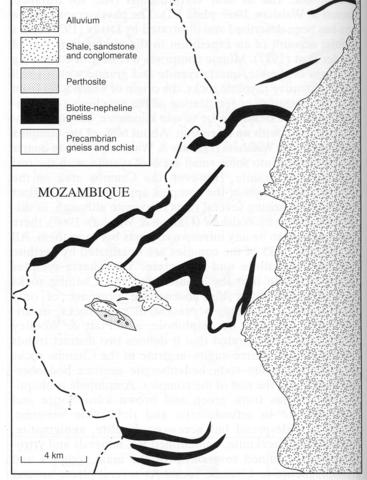stripes
Throughout the paragneisses of southern Malawi, from just north of Nsanje southwards to the border with Mozambique, biotite-nepheline gneisses form long, narrow bands which have been deformed in broad open folds (Bloomfield, 1958 and 1968). The average thickness of the bands is about 360 m and, according to Bloomfield, there were probably originally only two horizons which had a strike length in excess of 30 km. Contacts, where exposed, are gradational with the country rock biotite-plagioclase gneisses and simply expressed by the addition of nepheline. The nepheline gneisses generally vary only in terms of grain size and degree of foliation. A typical foliated type comprises thin biotite-rich laminae which are separated by bands a centimetre wide consisting of perthite and nepheline, but there are also varieties in which the biotite forms clots and thick folia containing abundant zircon separated by bands of almost pure nepheline. Rather more common are non-foliated varieties that have an igneous appearance and consist of a coarse aggregate of nepheline and feldspar, with randomly orientated biotite and plentiful zircon. There are also irregular stringers and segregations of pegmatite. Mineralogically all the nepheline gneisses are very similar comprising perthite, minor albite, nepheline, biotite, rare calcic amphibole and accessory ilmenite, magnetite, pyrite and zircon; alteration products of nepheline include cancrinite and zeolites. The pegmatites include euhedral nephelines up to five centimetres in length together with perthite, biotite and/or muscovite and patches of corundum.
ALLEN, J.B. AND CHARSLEY, T.J. 1968. Nepheline-syenite and phonolite. Her Majesty’s Stationery Office, London. 169 pp.BLOOMFIELD, K. 1958. The geology of the Port Herald area. Bulletin, Geological Survey of Malawi, 9: 1-76.BLOOMFIELD, K. 1968. The pre-Karoo geology of Malawi. Memoir, Geological Survey of Malawi, 5: 1-166.

